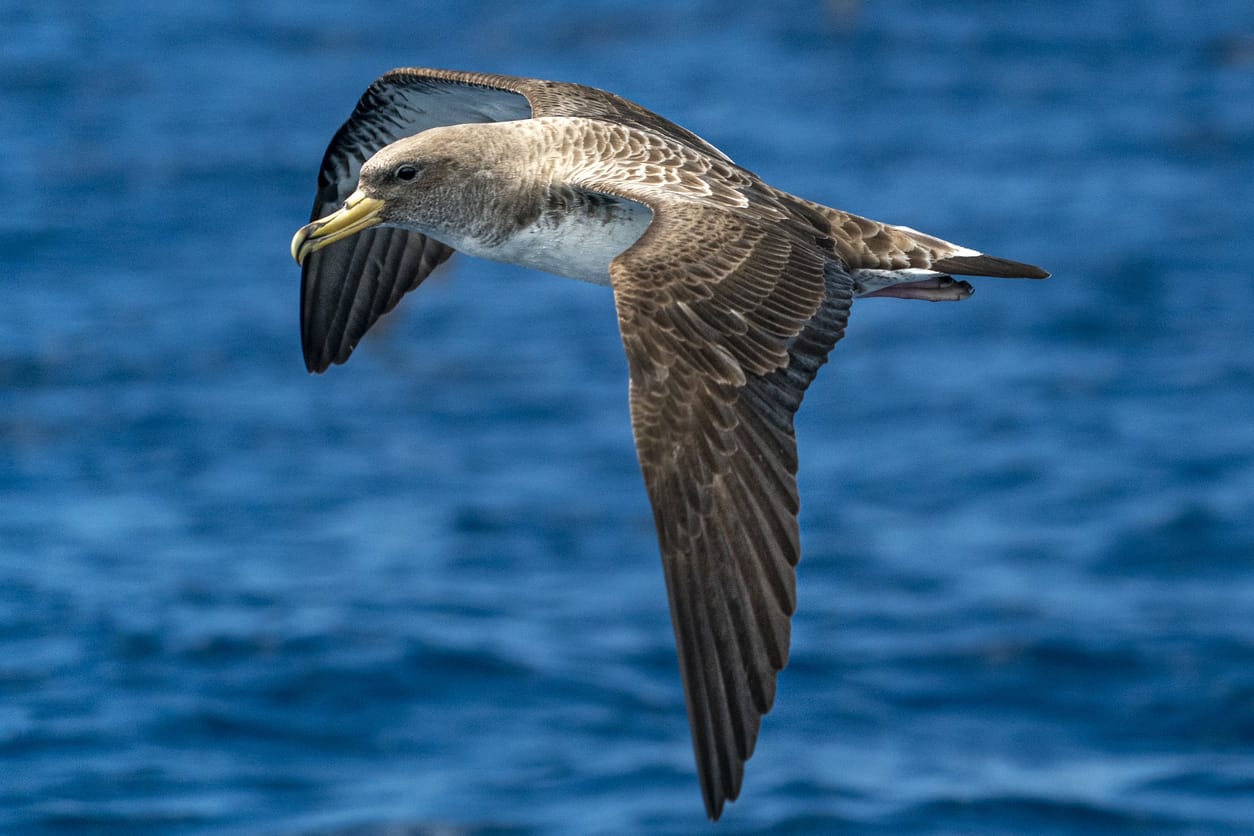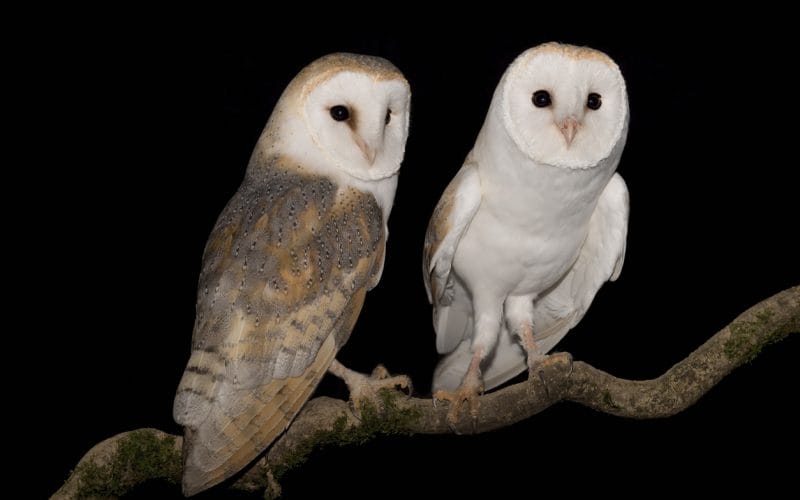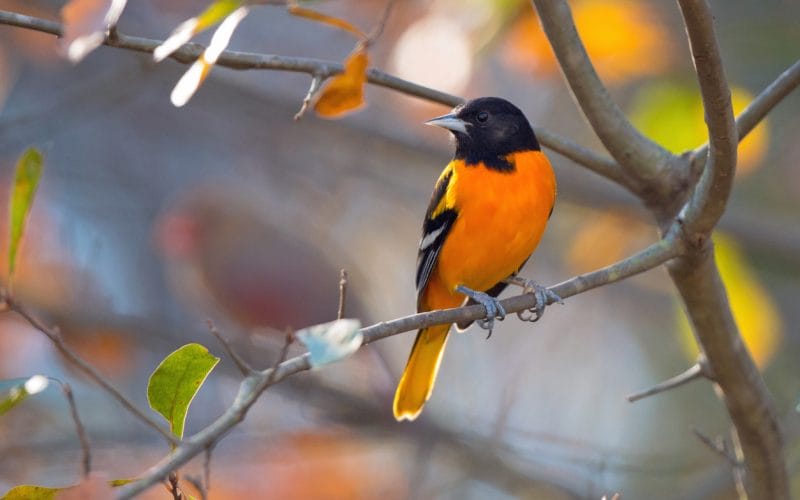Washington is the only American state named after a president and is the home of the first Starbucks. But these aren’t the only interesting things to know about the Evergreen State.
With an oceanic coastline of about 157 miles and more than 8000 lakes, there are a lot of seabirds and shorebirds that you can study and watch. Read this article to learn more about the most famous Washington seabirds.
13 Wonderful Washington Seabirds to Spot
Grab your binoculars because there’s a big chance that you’ll encounter some of these seabirds if you’re heading to the beach or a lake in Washington.
1. Bonaparte’s Gull

- Scientific name: Chroicocephalus philadelphia
- Length: Between 11 and 15 inches
- Weight: Between 6.3 and 7.9 ounces
- Wingspan: Between 30 and 33 inches
The Bonaparte’s Gull is one of the most common seabirds to find in Washington. It’s an all-white bird with a small head that gets darker during the breeding season. The upperparts are darker than the underparts, and it has orange-red feet.
This small gull is commonly found in winter in coastal habitats, freshwater habitats, and on sandy shores. When it’s nesting, it mainly feeds on insects, but during the non-breeding season, it feeds on fish and other marine creatures.
Author Note: Unlike other gulls, it usually nests in trees and not on the ground, where the nest would typically be between 4 and 15 feet off the ground.
2. Brandt’s Cormorant

- Scientific name: Urile penicillatus
- Length: About 34 inches
- Weight: About 4.6 pounds
- Wingspan: About 4 feet
The Brandt’s Cormorant is a black bird with a distinctive cobalt-blue throat and blue eyes. It has some whiskery white feathers on the head, neck, and shoulders that grow during the breeding season.
It’s commonly found in the coastal islands of Washington and the Upper Puget Trough, as it inhabits rocky shorelines and the open ocean. It usually nests on the slopes rather than steep cliffs.
These birds usually fly low in large flocks, often feeding with other seabirds. The Brandt’s Cormorant hunts fish from the surface but can dive up to 230 feet to catch schooling fish from below. It feeds on plainfin midshipman, monkeyface prickleback, Pacific sanddab, shrimp, crab, and squid.
3. Sooty Shearwater

- Scientific name: Ardenna grisea
- Length: Between 16 and 20 inches
- Weight: Between 1.43 and 2.1 pounds
- Wingspan: Between 37 and 43 inches
The Sooty Shearwater is an all-dark brown bird with silver underwings. Large flocks of the Sooty Shearwater can be seen along the coasts of Washington during fall, spring, and summer, but this bird is quite rare in winter. Pelagic birding trips are your best chance to watch this bird closely.
Top Tip: It flies low over the ocean, often using the wind to travel great distances. It’s also an amazing diver and can dive up to 220 feet to pursue its prey.
The Sooty Shearwater has a strong sense of vision that allows it to target schooling fish at night and mainly feeds on Pacific anchovies, Pacific saury, and different types of squid.
4. Western Gull
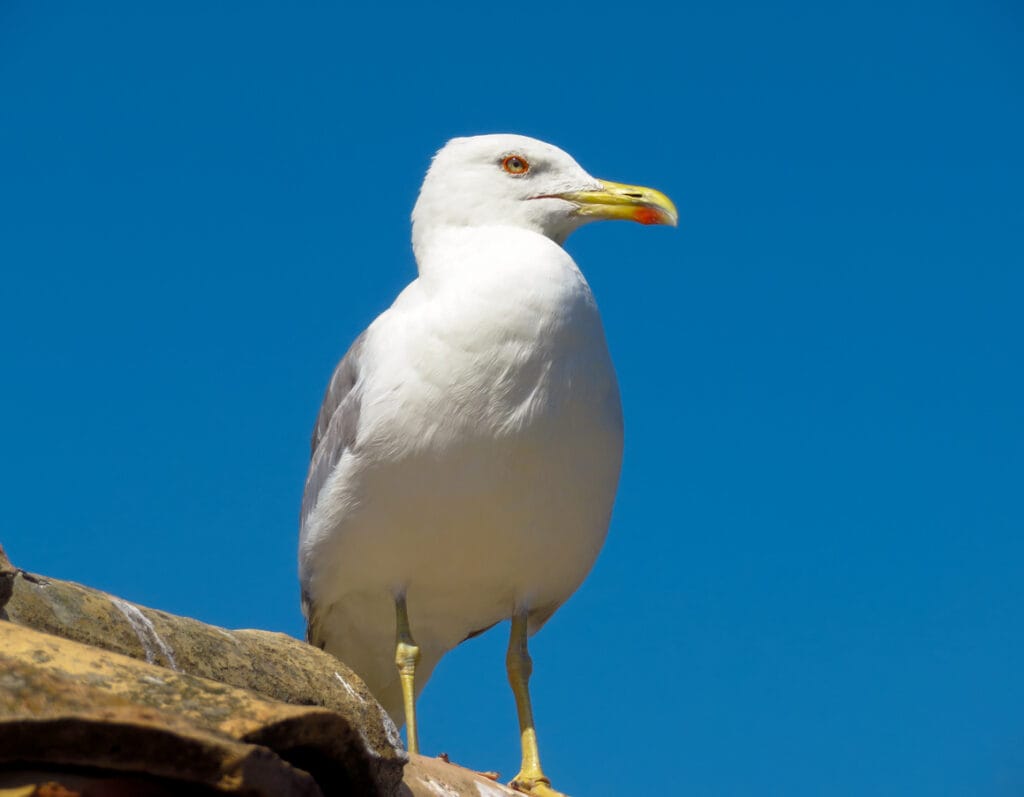
- Scientific name: Larus occidentalis
- Length:Between 22 and 27 inches
- Weight: Between 1.8 and 3.1 pounds
- Wingspan: Between 51 and 57 inches
The Western Gull is a heavy-bodied white gull with a dark gray back and upper wings. It’s commonly found across the coasts of Washington throughout the year, where large colonies can be found in Willapa Bay and at Grays Harbor.
In addition to beaches, the Western Gull uses multiple habitats, including garbage dumps and fields, but is rarely seen far inland. It usually nests on islands and abandoned piers, with colonies close to other seabirds and marine mammals.
This bird can live up to 30 years and is an opportunistic feeder that feeds on different types of marine live prey and food remains left by humans. Western gulls also feed on eggs, nestlings, and stolen food from other gulls and seals.
5. Marbled Murrelet

- Scientific name: Brachyramphus marmoratus
- Length: Between 9.4 and 9.8 inches
- Weight: Between 9.1 and 12.6 ounces
- Wingspan: Between 9.5 and 10 inches
This bird has a brown above and a mottled below with brown and off-white markings. Non-breeding birds have white underparts and black crowns and wings.
The Marbled Murrelet can be found along the shallow coastal waters and in protected fiords and bays all year long, heading to the southern parts of Washington during Winter. It nests in forests that can be about 45 miles away from the shore.
Author Note: The female usually lays one egg in a nest that’s most likely located on a branch that’s about 150 feet off the ground.
It usually forages for food in less than 100 feet deep waters, mainly feeding on Pacific anchovies, Pacific sand lances, Pacific herrings, and small crustaceans.
6. Tufted Puffin

- Scientific name: Fratercula cirrhata
- Length: About 14 inches
- Weight: About 1.6 pounds
- Wingspan: About 14 inches
Also known as the Crested Puffin, the Tufted Puffin is a stocky black bird with a white face, yellow feathers that extend from the eyes to the nape, and a bright yellow-orange bill. The yellow plumes are more prominent during the breeding season.
Your best chance to see a Tufted Puffin is to take a boat trip into the ocean, where this bird spends most of its time. It nests in deep burrows in the cliffs on Jagged Island and Alexander Island along the coast of Washington, where there are the two largest nesting colonies.
The Tufted Puffin’s wings function as fins underwater to help it chase its prey, which it usually consumes before emerging back to the surface. It feeds on small fish, squid, and crustaceans and will carry as many as 20 fish in its bill if it’s bringing food back to the nest to feed the young birds.
7. Common Murre

- Scientific name: Uria aalge
- Length: Between 15 and 18 inches
- Weight: Between 1.6 and 2.75 pounds
- Wingspan: Between 24 and 29 inches
The Common Murre or the Common Guillemot can be found in about 18 nesting locations along Coastal Washington, with about 10,000 birds per colony. It can be found all year round in Quillayute Needles Protected Area, Split Rock, Carroll Island, and Jagged Island, where it nests on rocky cliffs.
This bird is dark brown with a white belly, and it stands upright, like a penguin. Due to this reason, some people mistake it for one, although penguins aren’t related to these birds.
It feeds on small fish, squid, and octopus, and the female lays a single egg. Each egg has a different pattern and is very narrow at one end and broad at the other. If nudged, the egg will roll in a circle rather than fall off the cliff ledge.
8. Emperor Goose

- Scientific name: Anser canagicus
- Length: Between 26 and 28 inches
- Weight: Between 4.2 and 5 pounds
- Wingspan: About 47 inches
The Emperor Goose is a large goose with a gray overall, black and white edging on the feathers, a black throat, and a white head, resembling a crown that gave the goose its name. It’s a frequent winter visitor in Washington along the North Olympic and Pacific coasts and on the Columbia River banks.
Author Note: It’s usually found in the brackish wetlands and along the rocky beaches, using its bill to feed on mussels and marine invertebrates. The Emperor Goose also digs up roots and bulbs of grasses and sedges.
Emperor Geese usually mate for life, and the female usually builds the nest while the male watches out for predators like foxes and gulls. These birds forage for food with flocks of other geese, but they’re intolerant of their presence near the nest.
9. Pigeon Guillemot

- Scientific name: Cepphus columba
- Length: Between 12 and 15 inches
- Weight: Between 16 and 19 ounces
- Wingspan: Between 21.6 and 23.2 inches
The Pigeon Guillemot has dark brown plumage with white patches on the wings during the breeding season. The feet are bright red, and during the mating season, the male will walk around the female to show them off. It can be found throughout the year along the rocky coast of Washington and in Puget Sound.
It prefers to feed in shallow waters, although it can dive up to 148 feet. The short and narrow wings help it fly underwater, where it catches fish, worms, and crustaceans. It usually forages alone and away from other species.
10. Pelagic Cormorant

- Scientific name: Urile pelagicus
- Length: Between 25 and 35 inches
- Weight: Between 52 and 86 ounces
- Wingspan: About 3.3 feet
The Pelagic Cormorant is a blackish bird with a glossy green or purple highlight and a coral throat patch. There are several colonies of this bird in Puget Sound, where it nests on the coastal cliffs.
Top Tip: It mostly forages in the morning or late afternoon, where it looks for fish and other marine animals in rocky waters. It dives as deep as 138 feet and can hold its breath for up to two minutes, usually attacking schooling fish from below.
Despite its name, the Pelagic Cormorant is rarely seen away from the shore. It often perches on rocks while stretching its wings to dry them. Unlike other cormorants, the Pelagic Cormorant doesn’t forage for food in large flocks and catches fish either alone or in pairs.
11. Leach’s Storm-Petrel

- Scientific name: Hydrobates leucorhous
- Length: Between 7 and 8.2 inches
- Weight: About 1.5 ounces
- Wingspan: Between 16.9 and 18.8 inches
The Leach’s Storm-Petrel is a small seabird that looks uniformly black from below, but from above, it appears that the head and the back are brownish. It’s a summer resident of Washington, more commonly seen during July and August when the birds arrive at the breeding colonies on the Olympic Peninsula. Some birds have been recorded to live up to 24 years.
Taking an offshore boating trip improves your chances of encountering this bird as it usually forages away from the shore. However, a strong storm might drive this little bird closer to land.
The Leach’s Storm-Petrel forages near feeding whales or seals and usually catches crustaceans, fish, and squid. This bird also feeds on the fat slicks from dead marine animals.
12. Glaucous-Winged Gull
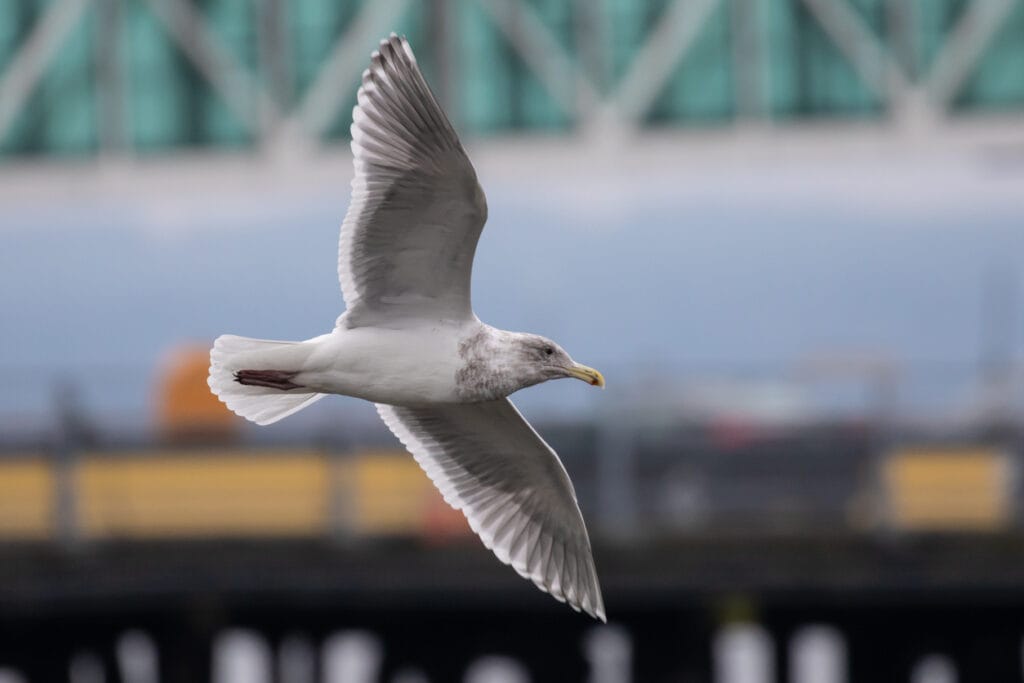
- Scientific name: Larus glaucescens
- Length: Between 20 and 27 inches
- Weight: Between 1.61 and 3.73 pounds
- Wingspan: Between 47 and 59 inches
The Glaucous-Winged Gull is a pearly gray bird with white underparts and a yellow bill. It can be found all year round along the coastline of Washington and in Seattle.
These birds sometimes mate with other gulls like the Western Gull, especially in the Puget Sound area, where the habitats of the two species overlap. This hybridization can lead to some identification issues, and in Washington, hybrids are more common than either species.
This opportunistic bird hunts its prey visually, feeding on crabs, oysters, clams, sea stars, and fish, usually dropping hard prey on the rocks to open it. Large flocks of the Glaucous-Winged Gull also feed on the schools of small fish and forage around fishing boats.
13. Semipalmated Plover

- Scientific name: Charadrius semipalmatus
- Length: Between 5.5 and 7.9 inches
- Weight: Between 0.78 and 2.22 ounces
- Wingspan: Between 14 and 22 inches
The Semipalmated Plover is a small bird with brown plumage, white underparts, and a back band across the chest. It’s a common spring and summer resident of Washington’s estuaries, where it prefers sandy beaches over the rocky ones.
Author Note: This bird has a short bill that it uses to forage for worms, crustaceans, and insects along lakeshores, sewage ponds, exposed sandy beaches, and river margins.
It gets into the water as long as it’s not more than an inch deep. The birds usually nest on grounds with little or no plant growth and forage alone, although they roost and nest in flocks.
Semipalmated Plovers have strong eyes that allow them to forage at night. They can swim for short distances, and young birds usually swim to follow their parents in shallow ponds.
In Conclusion
The coastline of Washington and its numerous lakeshores represent an adequate habitat for tens of seabirds and shorebirds. We managed to highlight some of the most famous Washington seabirds, but you can definitely encounter a lot more the longer the period you spend in this amazing state.
FAQ
It is most likely to be a cormorant. Check the list above for information about the Brandt’s and Pelagic Cormorant.
Across the globe, gulls are the most common marine bird. They can also be seen commonly inland as well.
You might see plovers, yellowlegs, stilt, avocets and sandpipers on the beaches of Washington.




